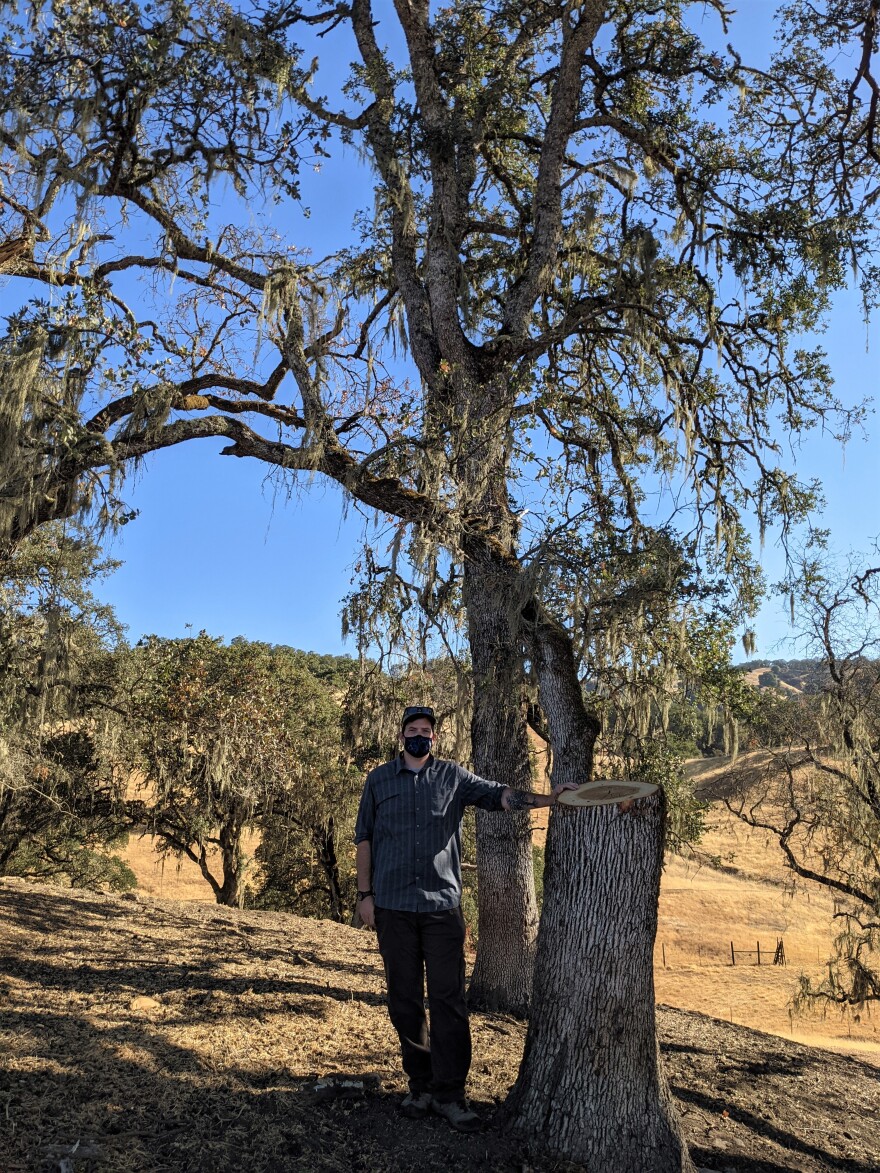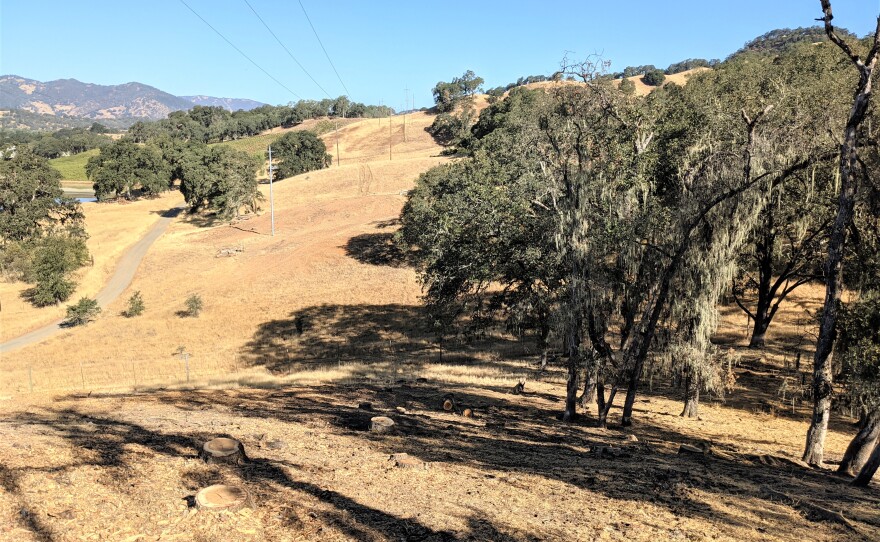September 21, 2021 — PG&E’s failure to maintain its equipment and the vegetation around its infrastructure has led to massive conflagrations in the past few years. Now the company is trying to clear fire hazards around its lines in high fire risk areas. But are they going too far? And is the enhanced vegetation management program even effective? The program is exempt from environmental review and forest practices rules, so those answers won’t be available for some time.

In June, company contractors cleared about 100 acres at the Hopland Research and Extension Center, which has been the site of ag and forestry research since 1951. I took a tour of the western boundary of the property with director John Bailey earlier this month.
There are two sets of power lines, about thirty or forty feet apart, and he estimated that the overall cleared area on either side of those lines was about 150 feet wide.
There are some ongoing projects at the property that involve studying the movements of deer and coyotes, Bailey is anticipating some impacts. “But it’s going to be a while,” he predicted. “It wasn’t like taking out any of the deer themselves, or radio collars or anything like that, but with a big wide-open highway through oak woodland, you’re going to see some changes in how the wildlife behave on the property.” PG&E crews also left six to eight inches of wood chips in pastureland along the lines. That’s not a problem for HREC, with its vast acreage and small flock, but Bailey said that the amount of bare ground overlain with wood chips would “definitely pose a problem if you were a smaller scale owner who was really economically dependent on that pasture productivity.”
Erosion is also a top concern for him. There are ag ponds below the cleared area, which he expects will catch the inevitable sediment from some of the scars. “If the ponds weren’t there, then it would flow straight on into the river,” he concluded.
A few days after my visit with Bailey, I hiked around a hilltop about a tenth of an acre at the same site

with Michael Jones, the University of California cooperative extension forestry advisor for Mendocino, Lake and Sonoma counties. We independently counted stumps on that one hilltop and each of us came up with 39 trees that were entirely cut down, including three trees that had had 90% of their branches removed. Four or five were pretty unhealthy, and there were a couple of big ones that were close to the lines and looked like they could have fallen on them.
Jones said the oak woodlands in the area were already in trouble, with no young trees coming up to replace the mature blue oak. He described the change in the landscape as conversion from an oak savannah to rangeland.
“If we know anything about clear cut and conversion,” he began, “if you don’t do follow-up vegetation management, then you get extensive fine fuels buildup, and the grasses and the shrubs come in aggressively, and the invasives come in really well, and you could have some other ecological impacts outside of the loss of the forest canopy structure.”
Bailey added that “often invasive species are the first ones to colonize after a disturbance.” He listed barbed goatgrass, star thistle, and medusa head as potential or already-existing problem weeds. “There’s great potential in some of these areas that they disturbed that we’ll just end up with strips of goat grass, because that’ll be the first thing to come back in.”
As for Jones, he’s not squeamish about vegetation management or thinning the forest. “I’m very much open to this idea of reducing fuels and fire risk, but what PG&E is doing is conversion. It’s really clear-cut and conversion along these right of ways that create really significant ecological impacts on the continuity of forest structure. These are like little clear-cut strips that hit right through habitat.” Even shaded fuel breaks, which he describes as “really powerful in helping us do fire suppression and defensible space management...still leave a portion of the canopy there. These are basically denuded of all their vegetation right now. It’s pretty aggressive, and frankly, it’s not sustainable,” ecologically or economically.
Bailey said that over the course of about three weeks, he spent between 12 and 15 hours negotiating with a foreman of the vegetation management crew. He was able to convince him to trim some trees rather than take them out entirely, and he prevented the removal of some young trees that were part of a research project. But the public resource code is on PG&E’s side, and he was in a bind that a lot of landowners and property managers find themselves in.
“I don’t want to be the place where catastrophic fires start, and it turns out that we pushed back too hard against PG&E, and they didn’t do what they said they should have done. So it’s this tricky balance of protecting your ecological values on your individual site, but also being aware of the larger societal value of having our distribution and transmission lines be as safe as they can.”
And Jones points out that in a way, PG&E is fulfilling its social contract, in a society that has not prioritized adapting to a fire-prone landscape. “I’m not saying they’re not at fault,” he said. “The way they’ve approached working with fuels and vegetation in the past is certainly a huge factor here. And so I think there’s not only accountability for them, but as a society, there’s accountability on us, and we need to all sit down at the table and figure out how we can do this better.”
There are a few other factors at work, too. Bailey reflected on drought, extreme heat, and the climate change that’s making giant, months-long fires a predictable reality. “We’re just reaching the point where we’ve created so many large-scale problems that the solutions themselves, whatever solutions we can come up with, create bad ecological impacts as well. We’re just in this era where we’re running out of good choices to make.”
Audio version of "Clear-cut at research center."




